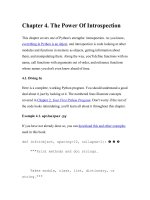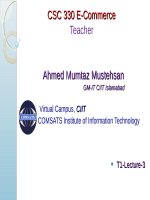Lecture E-Commerce - Chapter 4: The internet and the web (part II)
Bạn đang xem bản rút gọn của tài liệu. Xem và tải ngay bản đầy đủ của tài liệu tại đây (680.49 KB, 24 trang )
CSC 330 E-Commerce
Teacher
Ahmed Mumtaz Mustehsan
GM-IT CIIT Islamabad
•
•
Virtual Campus, CIIT
COMSATS Institute of Information Technology
•
T1-Lecture-4
The Internet and The Web
Chapter-2
Part-II
T1-Lecture-4
For Lecture Material/Slides Thanks to:
Copyright © 2010 Pearson Education, Inc
Objectives
Explain
the current structure of Internet.
Understand the limitations of todays internet
Describe the potential capabilities of Internet II
Understand how the world wide web works
Describe how internet and web features and
services support e-commerce.
T1-Lecture-4
Ahmed Mumtaz Mustehsan
Copyright © 2010 Pearson Education, Inc
1-3
The Hourglass Model of the Internet
SOURCE: Adapted from Computer
Science and Telecommunications
Board (CSTB), 2000.
T1-Lecture-4
Ahmed Mumtaz Mustehsan
Copyright © 2010 Pearson Education, Inc
1-4
The Hourglass Model of the Internet
The Internet can be characterized as an hour-glass
modular structure with a lower layer containing the bitcarrying infrastructure (including cables and switches)
and an upper layer containing user applications such
as e-mail and the Web.
In the narrow waist are transportation protocols such
as TCP/IP.
Network Technology Substrate layer
Layer-1 of Internet technology that is composed of
telecommunications networks and protocols
Transport Services and Representation Standards layer
Layer-2 of Internet architecture that houses the
TCP/IP protocol
T1-Lecture-4
Ahmed Mumtaz Mustehsan
Copyright © 2010 Pearson Education, Inc
1-5
The Hourglass Model of the Internet
Middleware Services layer
Layer-3: The “glue” that ties the applications to the
communications networks, and includes such services as
security, authentication, addresses, and storage
repositories.
Applications layer
Layer-4 of Internet architecture that contains client
applications; such as World Wide Web, e-mail, and
audio or video playback.
T1-Lecture-4
Ahmed Mumtaz Mustehsan
Copyright © 2010 Pearson Education, Inc
1-6
Internet Network Architecture
Metropolitan Area Exchanges (MAEs),
T1-Lecture-4
Ahmed Mumtaz Mustehsan
Network Access Points (NAPs)
Copyright © 2010 Pearson Education, Inc
1-7
Internet Network Architecture Concepts
Backbone:
◦ High-bandwidth fiber-optic cable networks
◦ Private networks owned by a variety of Network Service
Providers (NSPs).
◦ Bandwidth: 155 Mbps 2.5 Gbps
◦ Built-in redundancy
Network Service Provider (NSP)
Owns and controls one of the major networks comprising the
Internet’s backbone
Bandwidth
measures how much data can be transferred over a communications
medium within a fixed period of time; is usually expressed in bits per
second (bps), kilobits per second (Kbps), megabits per second
(Mbps),or gigabits per second (Gbps)
Redundancy
Multiple duplicate devices and paths in a network
T1-Lecture-4
Ahmed Mumtaz Mustehsan
Copyright © 2010 Pearson Education, Inc
1-8
Internet Network Architecture Concepts
Internet Exchange Points (IXPs).
Hubs where backbones intersect
with regional and local
networks, and backbone owners connect with one another
(older term NAPS)
Campus area networks (CANs)
LANs operating within a single
organization that leases
Internet access directly from regional or national carrier.
such as New York University or Microsoft Corporation
T1-Lecture-4
Ahmed Mumtaz Mustehsan
Copyright © 2010 Pearson Education, Inc
1-9
Internet Network Architecture Concepts
Internet Service Providers (ISPs)
Provide lowest level of service to individuals, small
businesses, some institutions
Narrowband
the traditional telephone modem connection, now
operating at 56.6 Kbps
broadband
refers to any communication technology that permits
clients to play streaming audio and video files at
acceptable speed generally anything above 100 Kbps.
Digital Subscriber Line (DSL)
a telephone technology for delivering high-speed
access through ordinary telephone lines found in homes
or businesses
T1-Lecture-4
Ahmed Mumtaz Mustehsan
Copyright © 2010 Pearson Education, Inc
110
Internet Network Architecture Concepts
Cable modem
A cable television technology that piggybacks digital
access to the Internet on top of the analog video cable
providing television signals to a home
T1 Line
an international telephone standard for digital
communication that offers guaranteed delivery at 1.54
Mbps
T3
an international telephone standard for digital
communication that offers guaranteed delivery at 45
Mbps
Satellite
bulk transfers at variable rates (250 Kbps–1 Mbps)
T1-Lecture-4
Ahmed Mumtaz Mustehsan
Copyright © 2010 Pearson Education, Inc
111
Intranets and Extranets
Intranet (Internal network)
A TCP/IP network located within a single
organization for purposes of communications and
information processing. e.g. Intranet of CIIT
Extranet (external network)
Formed when firms permit outsiders to access their
internal TCP/IP networks. e.g. General Motors
permits parts suppliers to gain access to GM’s
intranet
Note:
Intranets and extranets generally do not involve commercial
transactions in a marketplace, however, extranets supports
certain types of B2B exchanges
T1-Lecture-4
Ahmed Mumtaz Mustehsan
Copyright © 2010 Pearson Education, Inc
112
Who Governs the Internet?
Promoters of internet claim that no one governs internet as it is
public domain and inherently above and beyond the law.
However, there are certain organization that influence Internet and
monitor its operations such as :
Internet Architecture Board (IAB)
Internet Corporation for Assigned
Names and
Numbers (ICANN)
Internet Engineering Steering Group (IESG)
Internet Engineering Task Force (IETF)
Internet Society (ISOC)
World Wide Web Consortium (W3C)
International Telecommunications Union (ITU)
T1-Lecture-4
Ahmed Mumtaz Mustehsan
Copyright © 2010 Pearson Education, Inc
113
Limitations of current Internet Infrastructure
Bandwidth limitations: Backbone, MAN,CAN & last-mile
Quality of service limitations
Latency : delays in messages caused by the uneven flow of
information packets through the network.
“best-effort” quality of service (QoS), which makes no
guarantees about when or whether data will be delivered,
Network architecture limitations
Downloading same music by thousands of clients slows down
network performance as the same music track is sent out a
thousand times to clients that might be located in the same
metropolitan area
Language development limitations
HTML, the language of Web pages, is fine for text and simple
graphics, but poor at defining and communicating “rich
documents,” such as databases, business documents, or
graphics.
Wired Internet limitations
Copper cables use a old technology, and fiber-optic cable is
expensive to place underground. The wired nature of the Internet
T1-Lecture-4
Ahmed Mumtaz Mustehsan
Copyright © 2010 Pearson Education, Inc
restricts mobility
of users as compared
to wifi.
114
The Internet2® Project
Consortium of 200+ universities, government agencies, and
private businesses collaborating to find ways to make the Internet
more efficient, faster, reliable and affordable.
GigaPoP : a regional Gigabit Point of Presence, or point of
access to the Internet2 network, that supports at least one gigabit
(1 billion bits) per second information transfer
Primary goals:
Create leading edge very-high speed network for national
research community
Enable revolutionary Internet applications
Ensure rapid transfer of new network services and applications to
broader Internet community
T1-Lecture-4
Ahmed Mumtaz Mustehsan
Copyright © 2010 Pearson Education, Inc
115
The Larger Internet II Technology Environment:
GENI Initiative
Global Environment for Networking Innovations (GENI) Initiative
to develop new core functionality for the Internet, including new
naming, addressing and identity architectures;
enhanced capabilities, including additional security architecture
and a design that supports high availability;
new Internet services and applications
Proposed by NSF
to develop new core functionality for Internet
Most significant private initiatives (Fiber-Optic and Wireless)
Fiber optics is concerned with the first mile or backbone Internet
services that carry bulk traffic long distances.
Wireless Internet is concerned with the last mile from the larger
Internet to the user’s cell phone or laptop. Mobile wireless Internet
services
T1-Lecture-4
Ahmed Mumtaz Mustehsan
Copyright © 2010 Pearson Education, Inc
116
Fiber Optics and the Bandwidth Explosion in the
First Mile
“First mile”:
Backbone
Internet services that carry bulk traffic over
long distances
Older
cable
transmission lines being replaced with fiber-optic
Much
of fiber-optic cable laid in United States is “dark”,
but represents a vast digital highway that can be utilized in
the future
◦Photonic technologies expand capacity of existing fiber
lines
T1-Lecture-4
Ahmed Mumtaz Mustehsan
Copyright © 2010 Pearson Education, Inc
117
Optical Fiber
T1-Lecture-4
Ahmed Mumtaz Mustehsan
Copyright © 2010 Pearson Education, Inc
118
Optical Fiber
Source: Adapted from Panko, Raymond, Business Data Communications and Networking (3 rd ed.), Upper
Saddle River, NJ: PrenticeHall, 2001, p. 278.
T1-Lecture-4
Ahmed Mumtaz Mustehsan
Copyright © 2010 Pearson Education, Inc
119
Mobile Wireless Internet Access: The Last Mile:
“Last mile”:
From
Internet backbone to user’s computer, cell
phone, PDA, etc.
Two
different basic types of wireless Internet
access:
1. Telephone-based (mobile phones,
smartphones)
2. Computer network-based
T1-Lecture-4
Ahmed Mumtaz Mustehsan
Copyright © 2010 Pearson Education, Inc
120
Telephone-based Wireless Internet Access
Evolution:
(1-G) The first generation of cellular networks were analogbased.
(2G) Second generation cellular networks
Relatively slow circuit-switched digital network that can
transmit data at about 10 Kbps
(2.5G) network interim cellular network
that provides speeds of 60–144 Kbps using General Packet
Radio Services (GPRS)
GPRS (General Packet Radio Services) : next generation
technology carries data in packets, just like the Internet, but
over radio frequencies that make wireless communication
possible.
(3G) Third generation cellular network new generation of
cellular phone standards that can connect users to the Web
1at 2.4 Mbps
T1-Lecture-4
Ahmed Mumtaz Mustehsan
Copyright © 2010 Pearson Education, Inc
21
Telephone-based Wireless Internet Access
Competing 3G standards
GSM (Global System for Mobile Communications) mobile
communications system widely used in Europe and Asia that
uses narrowband Time Division Multiple Access (TDMA)
CDMA (Code Division Multiple Access) mobile
communications system widely used in the United States that
uses the full spectrum of radio frequencies and digitally
encrypts each call
(4 G) Fourth Generation: (LTE and WiMax )
Long Term Evolution:
True broadband cell phone provides up to 100 - 300 Mbps
WiMax
Alternative to LTE wide area network for cities provides 72
Mbps.
T1-Lecture-4
Ahmed Mumtaz Mustehsan
Copyright © 2010 Pearson Education, Inc
122
Wireless Local Area Networks (WLANs)
Wi-Fi
High-speed, fixed broadband wireless LAN, different versions
for home and business market, limited range.
WiMax
High-speed, medium range broadband wireless metropolitan
area network.
Bluetooth
Low-speed, short range connection.
Ultra-Wideband (UWB)
Low power, short-range high bandwidth network.
Zigbee
Short-range, low-power wireless network technology for
remotely controlling digital devices.
T1-Lecture-4
Ahmed Mumtaz Mustehsan
Copyright © 2010 Pearson Education, Inc
123
Wi-Fi Networks
T1-Lecture-4
Ahmed Mumtaz Mustehsan
Copyright © 2010 Pearson Education, Inc
124









